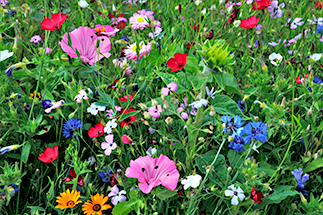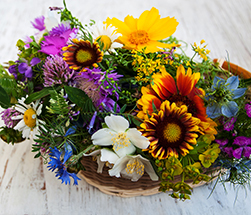Are you thinking of trying your hand at cut-flower growing? Cut-flower gardening is a beautiful way to foster some creativity right in your own backyard or even balcony. Wherever your cut flowers end up—on your kitchen table, in a loved one's home, or your local community center—they are sure to bring joy to anyone who beholds them.
1. Sow annuals directly into the garden.
For first-time cut-flower gardeners, annuals that can be directly sown in the garden are the easiest choice. Most annuals bloom prolifically for most of the growing season without the commitment (plants coming back year after year) and waiting period (often taking two seasons to bloom unless started indoors) of perennials.
2. Sow a range of colors, heights, and textures.

The possibilities in floral design are endless, but in general, flowers, and greenery used in arrangements fall into one of these four categories: Line, form, mass, or filler. Line flowers are tall spires of closely-packed flowers or greenery (e.g., delphiniums, snapdragons) that create height as well as frame the arrangement, and look best in odd numbers. Form flowers are considered the focal flowers, often larger and/or uniquely shaped (e.g., sunflowers, poppies), and also look best in odd numbers. Mass flowers (e.g., bachelor's buttons, marigolds) and greenery provide visual balance to the areas around the focal flowers. Lastly, fillers are airy greenery or small sprays of flowers (e.g.,tall verbena) that connect the line and form flowers in the design adding attributes like softness, contrast, and/or harmony to the entire arrangement. How you use or exclude these elements will change the theme or mood of the arrangement, so don't limit yourself!
3. Grow in rich, well-drained soil.
Conduct a soil test to know if you need to amend the soil. In general, cutting flowers benefit from balanced nutrition (equal parts nitrogen, phosphorus, and potassium) with weight toward phosphorus as they approach blooming. A phosphorous-rich fertilizer can be added as a side dressing or in liquid form about 6 weeks after plants have been in the ground. A nitrogen-rich flower garden tends toward beautiful, leafy plants, but few blooms, so don't overdo it on nitrogen.
4. Sow varieties by height.
Sow taller varieties in the back of the bed so they do not shade the shorter flowers. Be sure to give yourself walking room, too, so you can easily harvest all of your flowers. For extra-long stems for use in tall vases, sow seeds closer together (although, the blooms may be smaller). Remember to plan using the flowers' height when they are fully grown.
5. Support tall flowers.
Staking will help prevent damage from wind, strong rains, or heavy growth. Place the stake in the ground at sowing/transplanting time to avoid damaging roots. Use twine or a twist tie in a figure eight, putting one loop tightly around the stake and one loop loosely around the stem in a few places along the stake. A grid-style grow-through support can also be used to support stems as they grow up through it.
6. Water only the soil.
Take care to not wet the foliage of your cutting-garden plants. Water on leaves raises the humidity level, making plants more susceptible to fungal disease. Further, disease can easily spread through water droplets or splashed soil. A soaker hose or drip irrigation will help.
7. Cut early and often.
It may sound counterintuitive, but a proper cutting garden should be virtually bloom free. Harvest flowers when buds are just 50% open (in most cases) for the longest vase life. Cutting blooms from plants encourages plants to again put their energy into blooming rather than seed production. Once plants delegate their energy to seed production, blooming naturally slows or stops. This isn't to say you can't have your bouquets and landscape flowers, too, but keep in mind if you leave some flowers for general beauty or for pollinators, be sure to cut them before they go to seed to maximize bloom production.
8. Harvest flowers in the cool of morning.
Plants rehydrate overnight, so cutting them in the cool of the morning means they are full of water, thus lengthening their vase life. Put harvested flowers in water right away; if you wait, re-cut stems just as you put them in water to ensure any stem portion that has dried up won't inhibit the flowers' uptake of water.

9. Maintain cut-flower vase life.
The most effective methods for extending the vase life of your flowers are to change water daily, keep flowers out of direct sunlight, and re-cut stems often. Read more about Making Cut Flowers Last Longer.
10. Keep notes!
Periodically, review your garden and take notes on what is blooming when, what you liked most, and colors or textures you may want to try in the future.
We hope you are blooming with ideas on what flowers you may incorporate into the garden for cutting! Remember, gardening is part art, science, and adventure so give something new a try!

